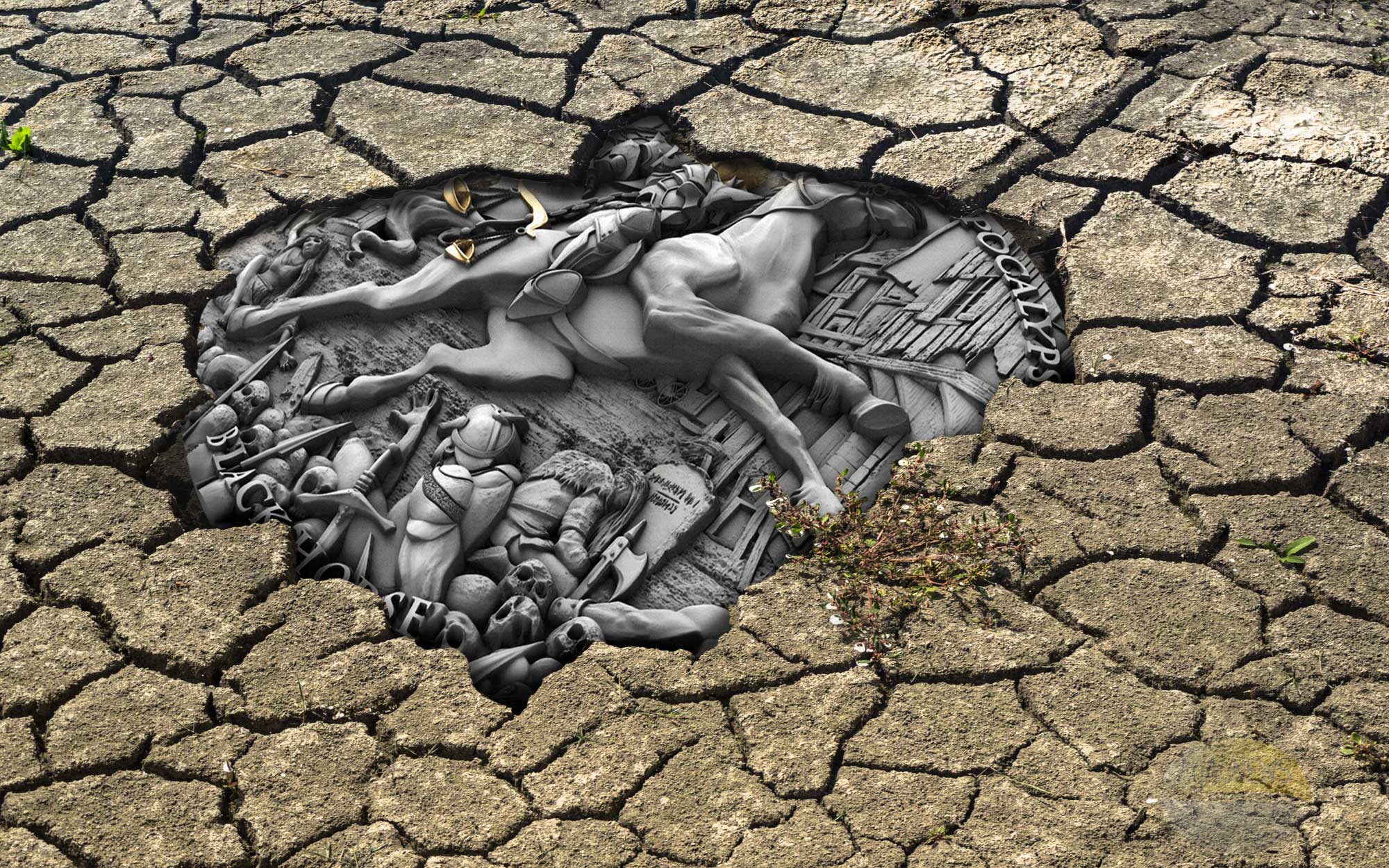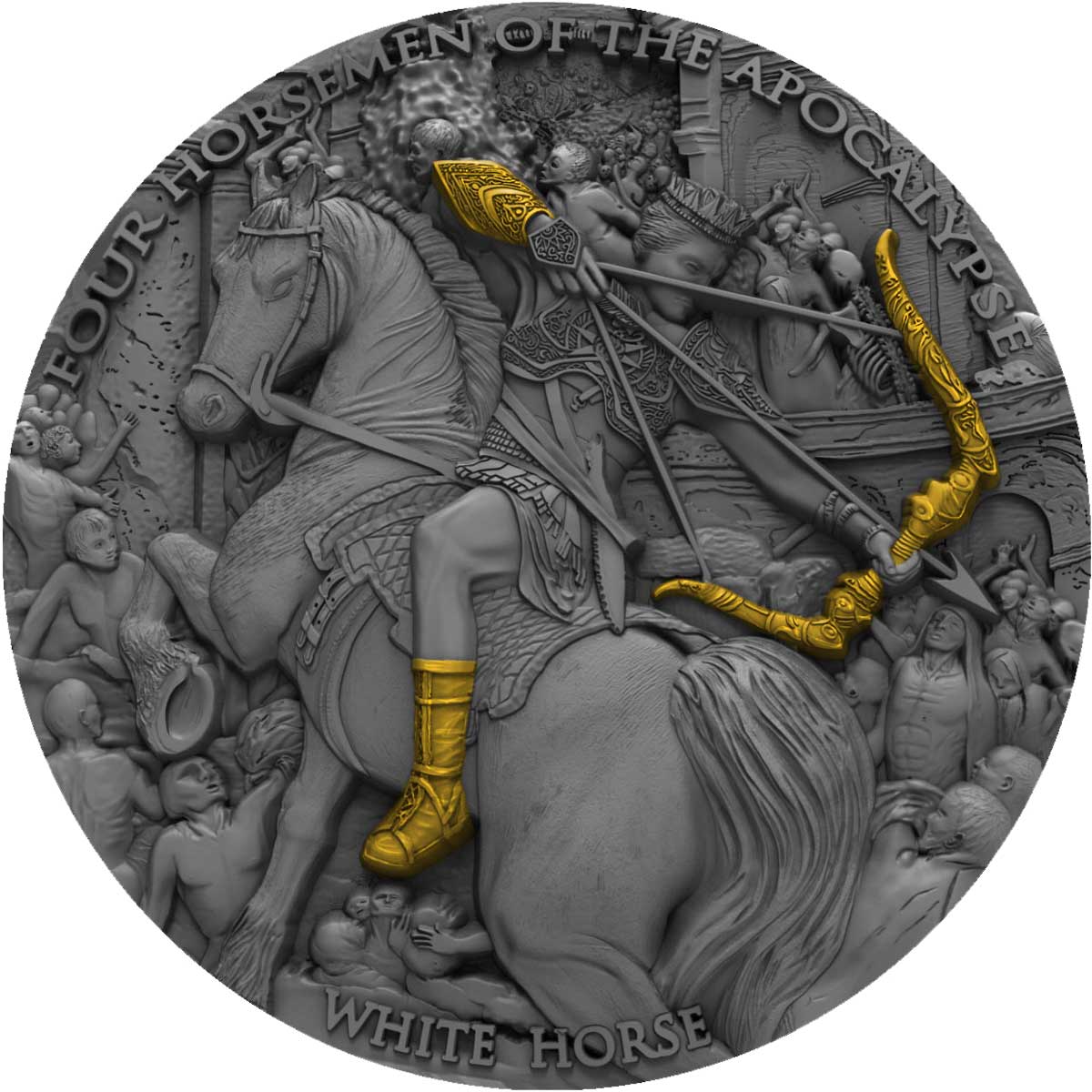WMF20 Exclusive: Famine, third of the Four Horsemen of the Apocalypse, rides its black steed onto a coin
Legendary religious forces, The Four Horsemen of the Apocalypse, are back for the Mint of Poland’s superb series of coins, and this time it’s the turn of the Black Horsemen, Famine. This is the third of the four to be issued to date, following the White Horseman (Pestilence) and the Red Horseman (War), with only the Pale Horseman, Death, yet to come.
Top design again, as you would expect from one of the finest series of its type, with a powerful depiction of the horse and rider taking centre stage. A medieval town scene in the background, with starving peasants and human skulls in the lower foreground place the main subject in context. All told, a well realised continuation of the design style of its predecessors.
The common obverse is back, incorporating the required effigy of Queen Elizabeth II, but placing it within a wider and attractive piece of equine art full of action and detail. Shipping date is yet to be revealed, but we’d expect it in the next 2-3 months and it should appear for pre-order at dealers in a few days time. Distributed by Canadian dealer Coin Shoppe, it has a mintage of 500 pieces and comes boxed with a C.O.A.
When He broke the third seal, I heard the third living creature saying, “Come.” I looked, and behold, a black horse; and he who sat on it had a pair of scales in his hand. And I heard something like a voice in the centre of the four living creatures saying, “A quart of wheat for a denarius, and three quarts of barley for a denarius; but do not damage the oil and the wine.” Revelation 6:5-6
THE FOUR HORSEMEN
The Four Horsemen of the Apocalypse are described in the last book of the New Testament of the Bible, called the Book of Revelation of Jesus Christ to John of Patmos, at 6:1-8. The chapter tells of a book or scroll in God’s right hand that is sealed with seven seals. The Lamb of God opens the first four of the seven seals, which summons four beings that ride out on white, red, black, and pale horses.
Though theologians and popular culture differ on the first Horseman, the four riders are often seen as symbolizing Conquest or Pestilence (and less frequently, the Christ or the Antichrist), War, Famine, and Death. The Christian apocalyptic vision is that the Four Horsemen are to set a divine apocalypse upon the world as harbingers of the Last Judgment.
One reading ties the Four Horsemen to the history of the Roman Empire subsequent to the era in which the Book of Revelation was written. That is, they are a symbolic prophecy of the subsequent history of the Empire.
The third Horseman rides a black horse and is popularly understood to be Famine as the Horseman carries a pair of balances or weighing scales, indicating the way that bread would have been weighed during a famine. Other authors interpret the third Horseman as the “Lord as a Law-Giver” holding Scales of Justice. In the passage, it is read that the indicated price of grain is about ten times normal (thus the famine interpretation popularity), with an entire day’s wages (a denarius) buying enough wheat for only one person, or enough of the less nutritious barley for three, so that workers would struggle to feed their families.
Of the Four Horsemen, the black horse and its rider are the only ones whose appearance is accompanied by a vocal pronunciation. John hears a voice, unidentified but coming from among the four living creatures, that speaks of the prices of wheat and barley, also saying “and see thou hurt not the oil and the wine”. This suggests that the black horse’s famine is to drive up the price of grain but leave oil and wine supplies unaffected (though out of reach of the ordinary worker). One explanation for this is that grain crops would have been more naturally susceptible to famine years or locust plagues than olive trees and grapevines, which root more deeply.
The statement might also suggest a continuing abundance of luxuries for the wealthy while staples, such as bread, are scarce, though not totally depleted; such selective scarcity may result from injustice and the deliberate production of luxury crops for the wealthy over grain, as would have happened during the time Revelation was written. Alternatively, the preservation of oil and wine could symbolize the preservation of the Christian faithful, who used oil and wine in their sacraments. (Source: Wikipedia)
| SPECIFICATION | |
| DENOMINATION | $5 NZD (Niue) |
| COMPOSITION | 0.999 silver |
| WEIGHT | 62.2 grams |
| DIMENSIONS | 45.0 mm |
| FINISH | Antique |
| MODIFICATIONS | Gilded highlights, ultra high relief |
| MINTAGE | 500 |
| BOX / C.O.A. | Yes / Yes |








Nice…but will probably get lost in the shuffle of the 5000 other look alike pieces. Lol. Great pics!
This is an outstanding series-both artistically & thematically. It’s also a cut way above all of the pale imitations, don’t you think Bob? This set is one to have & will be worthwhile over time imho.
It’s a nice, tight set with a consistent theme and release schedule.
‘Investor’, keep it civil please. If I see this is going to descend into another slagging match, I will end it as its been done elsewhere on site. I’ve removed one comment. We’re trying to highlight new coins for people to look at, and what people choose to do with those coins is their choice. Both reasons to buy or not to buy are equally valid for different people. AgAuNEWS is about showing you new issues so you can make that decision for yourself. Feel free to post comments on the coins, but no more personal stuff or rehashing the same old arguments.
Well said Mik.
I went back & looked at White Horse & Red Horse now. Anxious to have Black Horse in hand. Quite simply, this will be a stunningly beautiful set. Ten years from now this will be a stunningly beautiful set-groundbreaking in its beauty & story. What can I say, these coins have cast a spell on me-I love them.
Mik,Any idea as to when the fourth coin in the series will be issued? Any previews forthcoming?
Hi Harry. Yes, it’s coming reasonably soon. We don’t have previews yet, but you’ll be the first to know. 😉